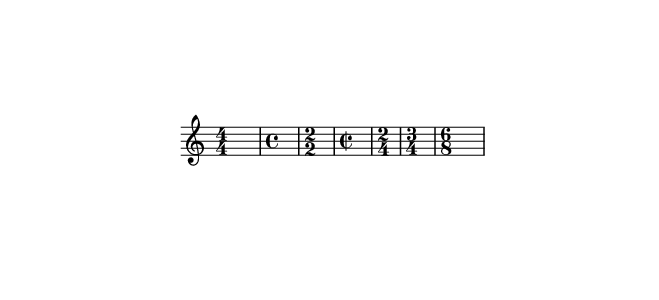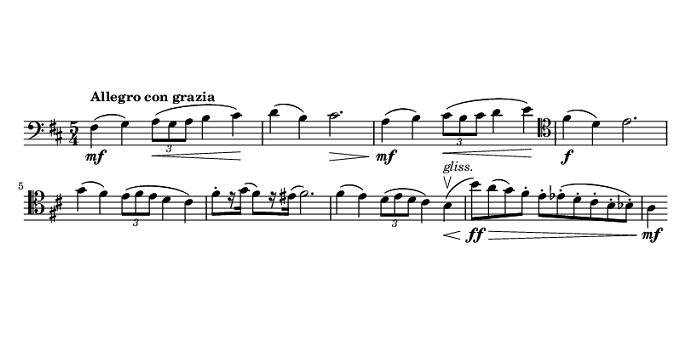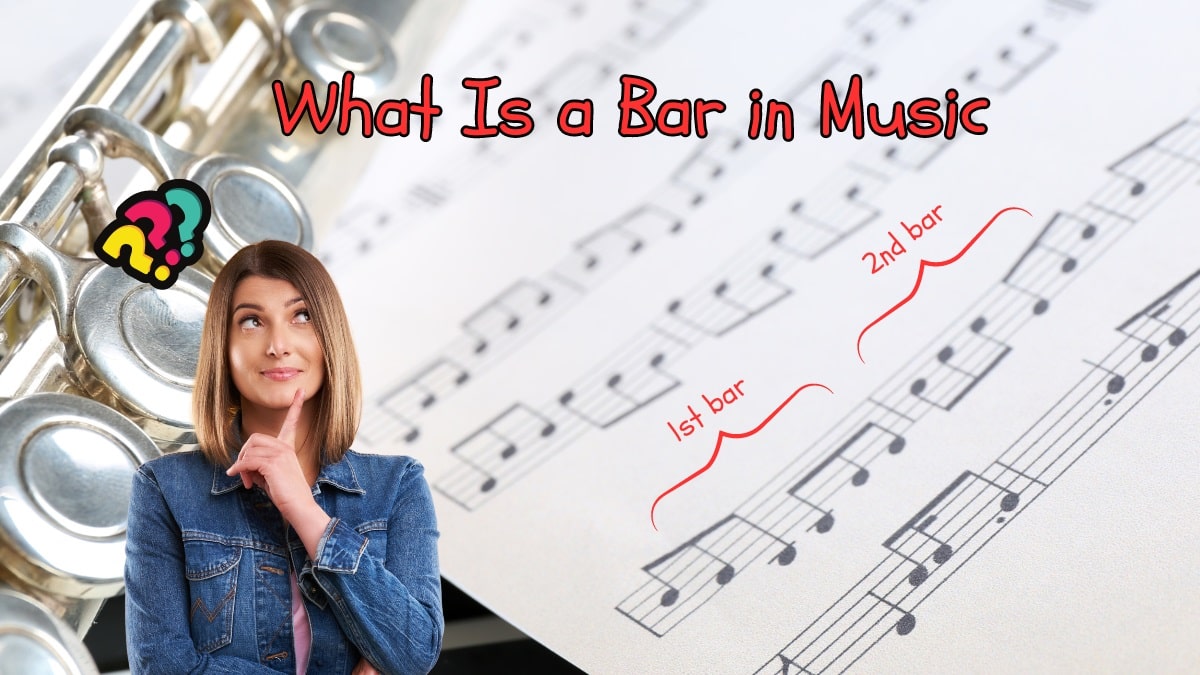Composing music isn’t an easy job, is it?
First, you need to think of a rhythm. Then, you need to break it into subdivisions and choose a time signature for it. And of course, you need to write the notes, which isn’t a walk in the park.
If you don’t know what a bar means, forget all of that.
Understanding all the musical terms involved in composing is vital if you want to get the complete picture. So, before we go into time signatures and tempos, let’s first explain what a bar in music means.
What Is a Bar in Music?
A bar is a term used in writing music, and it’s otherwise referred to as measure. It’s basically a single time unit that consists of several beats played at a specific tempo. Additionally, it’s indicated by vertical bar lines that you probably saw in musical notes before.
The lines run perpendicular to the staff lines, denoting the start and end of a bar. There are various types of bar lines, and we’ll explain them all later below.
When composers write their music, they divide it into smaller subdivisions of beats and pulses, so the performers will be able to play their parts exactly as they should. Bars are the time intervals that contain the beats of the piece.
Time signatures are crucial to understanding how bars work, and we’ll talk about them in detail later. They indicate how many beats are in one bar.
A measure is just a different term to describe a bar.
Different Types of Bar Lines Explained

Bars are indicated in bar lines that run perpendicularly against the staves—the horizontal lines that musical notes are written onto.
They’re vertical lines that composers use to break their music into bars. As a result, the notes are simple to look at and decipher for the performers.
There are five common types of bar lines. Here’s a preview of each one of them.
Single Bar Line
The single bar line is by far the most basic line in this list. It only serves to tell the performer where the measure is and divide it into smaller parts. So, a single bar line signals the end of the bar and its beats.
Double Bar Line
Double bar lines are drawn close to each other, and they’re used to separate a passage of music into sections. So, single bar lines indicate the end of a measure and the start of another. And the double ones indicate the end of a section and the beginning of another.
You can add a double bar line before a key change, a bridge, or a chorus if you’re changing the style. You can also change it right before a tempo or a shift in the time signature.
End Bar Line

An end bar line is drawn in two vertical lines, the first of them being thinner than the other. Composers add it to indicate the end of a whole composition or a musical movement, so it’s technically the last line used in a piece.
Start Repeat Line
The start repeat line is drawn in two vertical lines, the first one being thicker than the second. Plus, they’re followed by two dots above each other, looking like a colon.
Composers add start repeat lines to indicate the start of the first bar of a repeated section.
End Repeat Line
The end repeat line is drawn just like the start repeat line, except that it’s mirrored. Again, it’s drawn in two vertical lines, the first one being thinner than the second. But this time, the colon-like dots precede the two lines.
Composers add the end repeat line when they want to indicate the last bar of a repeated section.
How Are Bar Lines Written on a Staff?

When writing on a single staff, bar lines are written between the staff’s top and bottom. The same goes if you’re using ledger line notes; the bar line stays inside the staff lines.
On the other hand, when writing on a grand staff, you’ll write bar lines outside of the staff. Bear in mind that the area between the bass and treble staves is considered a part of the grand staff, so it’s not actually outside.
In this case, you write your bar lines from the treble staff’s top to the bass staff’s bottom. Or in other words, from the top of line 5 to the bottom of line 1.
How to Count a Bar of Music
Reading musical notations only seems complicated at a first glance. However, once you get to it and understand what all the symbols mean, you’ll find that it’s a pretty simple process.
Firstly, you need to know that musicians read their bars from left to right. So, if you want to learn how to count or read a bar, here are the steps to do so.
Step 1: Determine the Music’s Time Signature

The first step to counting bars of a musical composition is determining the time signature. Granted, the most common time signature in Western music is 4/4, but you never know what signature could come your way.
To do this, you need to listen closely and start counting the common time signatures in your head.
For example, you’ll start the song and begin counting with the beat. Do you know the beats that you clap along to? These are the ones you’ll count, and you may clap them if you’d like.
At first, try a 1-2-3-4 count because 4/4 is the most common signature. If it doesn’t match the song beats, move on to the ¾ time signature, which counts as 1-2-3, 1-2-3.
That didn’t work either? Move on to the 6/8 signature; it sounds like 1-2-3-4-5-6, 1-2-3-4-5-6.
You’ll eventually determine the music’s time signature. And with time, you’ll be able to realize the song’s time signature without attempting to count.
Step 2: Count the Bars
Now that you know the time signature of your song. It’s time to start counting the bars. For example, if the music follows the 4/4 signature, when you reach the fourth count, this indicates a full bar.
So, each time you finish a 1-2-3-4 count of the beats, count one bar, and so on. And the same goes if the song has any other time signature.
Other Musical Terms to Learn to Understand Bars

To read a bar of music, you need to understand all the musical terms associated with it. As you’ve seen, we frequently mention words like time signature and beats when talking about bars. That’s because they’re all somehow connected.
Here’s a roundup of all the musical terms you should learn to read bars on music.
Time Signature
If you’re a music-enthusiast, and you’ve been doing your homework researching, you’d undoubtedly run across the term time signature before. Composers use time signatures in music to indicate the number of beats in each bar or measure.
The top number of a time signature refers to the number of beats. Meanwhile, the number below refers to the duration of each separate beat.
For example, a 4/4 signature tells you that there are four beats in each bar or measure, and that the duration of each beat is a quarter note. It’s the most common signature in Western music, which is why it’s frequently called ‘common time.’
Beats
The time signature is the number of beats in each bar. But what are beats in the first place?
The beat is an essential element of music compositions. It’s the smallest measurement unit that composers use to create notes and keep them in sync with each other.
When you start clapping along with a song you’re listening to, you’re clapping to follow the beats. And the same goes for dancing.
Tempo

The tempo in music refers to the speed of a specific section. Musical writers indicate it by metronome markings using descriptive terms or beats per minute. These descriptive terms include andante, adagio, and allegro. However, these belong to the Italian terminology, which may be considered outdated now.
So, some people refer to the tempo using modern terminology instead. They use terms like relaxed, slow, and fast to refer to the music’s speed or tempo.
Tempo’s measuring unit is BPM or beats per minute. Try not to let the musical terms confuse you; the tempo refers to the pace of the music, while the beat refers to the music’s length. So, the BPM determines how fast the music goes.
Note Values
Note values are the individual notes in a single bar. They last for a specific duration, and it’s essential to understand these durations because they’re crucial in musical composition.
For example, in a bar that follows a 4/4 time signature, the quarter notes last for a quarter a bar. Meanwhile, eighth notes last for an eighth of the same bar, and so on.
Note values are easy to determine when you have the time signature of a song. Just look at the number on the bottom—if it’s a 4, then the value is a quarter note, and if it’s an 8, the value is an eighth note, and so on.
Common Time Signatures: How Many Beats Per Bar?

Along with the 4/4 time signature, there are a couple of common ones in Western music. Learning about them makes it easier for you to understand how bars work and how to read them.
Here’s a brief roundup of some simple time signatures:
2/2 Time Signature
The 2/2 signature may be the second most common one after the 4/4. It’s often called ‘cut time’ because it’s common time, but it’s cut in half. It denotes that each bar consists of two half beats.
When listening to it, it’ll sound strikingly similar to the 4/4 note, so you may not be able to count it differently. However, it emphasizes the third note in each bar, so you may be able to detect it if you practice long enough.
On the vertical lines of musical notes, composers draw 2/2 notes as a letter C with a vertical line passing through it.
¾ Time Signature
The ¾ is another famous time signature that consists of three beats in every bar. Its most use was in the 19th century because of its waltz sound. You can hear it clearly in some classic pieces, such as Que Sera Sera.
6/8 Time Signature

The 6/8 signature means that there are six beats in each bar, and the notes used are eighth notes. You may wonder why it doesn’t sound the same as the ¾ signature since they both result in the same numbers. However, the 6/8 signature is divided into two groups, each group containing three eighth notes.
Meanwhile, the ¾ signature divides into three groups, each group containing two eighth notes.
How to Read Time Signatures
To read bars, you first need to be able to read time signatures. This way, you’ll determine how many beats the bar should consist of. Reading time signatures is actually relatively easy as long as you know what the signatures mean.
The top number of a signature indicates how many beats are in a single bar. As for the bottom number, it refers to the note value, which is basically the duration of each beat.
To know the note value of any signature, you only need a simple calculation. For example, to see the note value of 4, ask yourself, what does a whole note need four of to form? The answer is quarter notes.
If you’re trying to find the note value of 8, a note needs eight eighth notes to form. So, the note value here is the eighth note.
If you still find this hard, we’ll give you an easy tip to read time signatures.
- One on the bottom: the beat consists of a whole note
- Two on the bottom: half notes
- Four on the bottom: quarter notes
- Eight on the bottom: eighth notes
- 16 on the bottom: sixteenth notes







